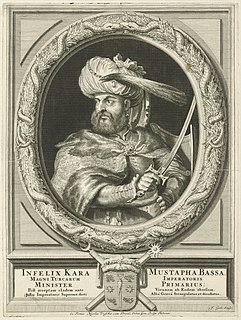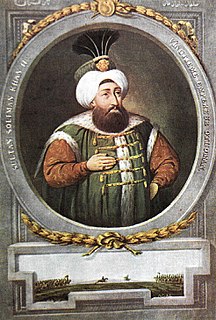 W
WAhmed II was the Sultan of the Ottoman Empire from 1691 to 1695.
 W
WSheikh Mustafa Gaibi or Gaibija was a 17th-century dervish from Ottoman Bosnia whose mausoleum (turbe) at Stara Gradiška in Slavonia, in present-day Croatia, became a prominent site of ritual visitation by Muslims. He was regarded as a prophet by some Catholics. He wrote in Ottoman Turkish a discourse on the rules of the Jelveti Sufi order, to which he belonged. He also wrote letters in which he criticized various kinds of wrongdoing that he regarded as widespread in the Ottoman Empire. His letters contain mystical-looking expressions that are difficult to understand. He is reputed to have predicted the defeat of Ottomans at the Battle of Vienna in 1683 and the subsequent loss of their territories north of the river Sava. According to a local Catholic source, an Ottoman soldier killed Gaibi in Stara Gradiška, at the left bank of the Sava, after he refused to escape with other Muslims across the river before the advancing Habsburg army; they captured Stara Gradiška in 1688. In 1954, his turbe was transferred across the Sava, to the town of Gradiška in Bosnia and Herzegovina.
 W
WAlexander Mavrocordatos was a member of the Greek Mavrocordatos family, a doctor of philosophy and medicine of the University of Bologna, and Dragoman of the Porte to Sultan Mehmed IV in 1673 — notably employed in negotiations with the Habsburg Monarchy during the Great Turkish War.
 W
WMehmed IV also known as Mehmed the Hunter was the Sultan of the Ottoman Empire from 1648 to 1687. He came to the throne at the age of six after his father was overthrown in a coup. Mehmed went on to become the second longest reigning sultan in Ottoman history after Suleiman the Magnificent. While the initial and final years of his reign were characterized by military defeat and political instability, during his middle years he oversaw the revival of the empire's fortunes associated with the Köprülü era. Mehmed IV was known by contemporaries as a particularly pious ruler, and was referred to as gazi, or "holy warrior" for his role in the many conquests carried out during his long reign.
 W
WMustafa II was the Sultan of the Ottoman Empire from 1695 to 1703.
 W
WMerzifonlu Kara Mustafa Pasha was an Ottoman nobleman, military figure and Grand Vizier of Turkish origin, who was a central character in the Ottoman Empire's last attempts at expansion into both Central and Eastern Europe.
 W
WHussein Mezzomorto or Hajji Husain Mezzomorto was an Ottoman privateer, bey (governor), and finally Grand Admiral of the Ottoman Navy. His epithet mezzomorto is the Italian for "half-dead" and was acquired during a fight with the Spaniards, when he was gravely injured.
 W
WSarı Süleyman Paşa was the grand vizier of the Ottoman Empire from 18 November 1685 to 18 September 1687. He was executed after the defeat of the Ottoman forces in the Battle of Mohács (1687).
 W
WSuleiman II was the Sultan of the Ottoman Empire from 1687 to 1691. After being brought to the throne by an armed mutiny, Suleiman and his grand vizier Fazıl Mustafa Pasha were successfully able to turn the tide of the War of the Holy League, reconquering Belgrade in 1690, as well as carrying out significant fiscal and military reforms.